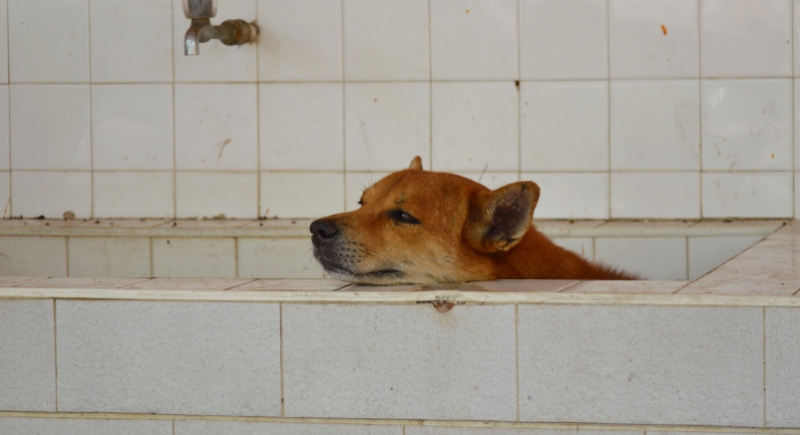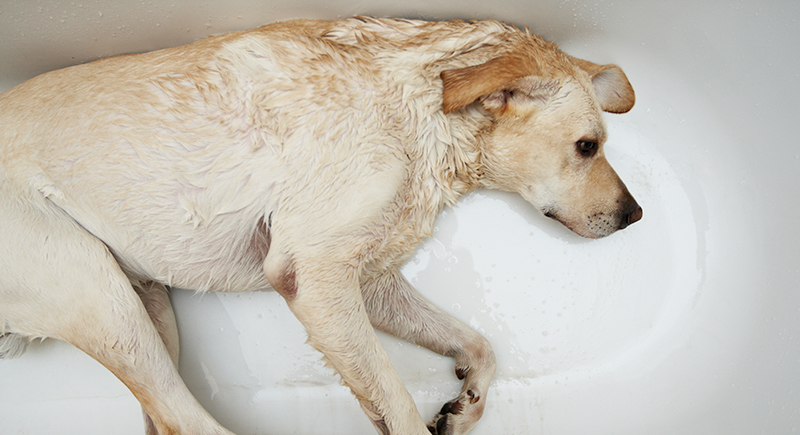Why Do Dogs Randomly Sleep in the Bathtub?
You walk into the bathroom and find your dog curled up in the tub, looking perfectly at home. It might seem strange, but there’s usually a reason for it. Dogs often retreat to the bathtub because it feels cool, quiet, and safe—a spot that muffles noise and gives them a sense of control.
Sometimes it’s their way of coping with stress, loud sounds, or shifts in their environment. Other times, it can signal discomfort or illness. Noticing when and how often it happens can help you understand what’s really going on and find healthier, more comfortable spaces for them to rest.
Cooling Off on Hard Surfaces

Image via Getty Images/pedphoto36pm
Porcelain and tile hold cool temperatures much longer than carpet or fabric, and dogs instinctively notice that difference. Thick-coated breeds and larger dogs who struggle to regulate body heat often sprawl on bathroom floors or inside tubs for comfort. Unlike humans, canines don’t rely on sweat to cool their bodies, so direct contact with cold surfaces provides relief. This becomes especially common in warm climates or during summer months when indoor temperatures rise.
Owners sometimes misinterpret the choice as strange tendencies, but it’s often an efficient way for dogs to lower their body temperature. Providing shaded areas, cooling mats, and access to fresh water in other parts of the home can give them safer alternatives. Observing the frequency and duration of these bathtub visits can also help determine if the habit is purely about heat or part of a larger pattern related to stress or discomfort.
The Tub as a Protective Den
Canines naturally like enclosed areas that resemble dens, which provide a shielded environment away from constant activity. A bathtub offers high walls and isolation, which make it feel more secure than an open bed in a busy living room. Many anxious or fearful pups use this instinct to cope with uncertainty.
For example, if the household has new pets or more human activity, the tub can act as a retreat where they feel left alone. Dogs that prefer privacy while resting may return repeatedly. This is not unusual, since wild canines rely on dens for rest and protection.
To redirect the behavior, owners can create a similar setup in another room. Placing a crate in a quiet space and covering it with a blanket mimics the enclosed structure of a bathtub but keeps the pup out of areas where hazards like cleaning products may exist.
Anxiety and Environmental Triggers

Image via iStockphoto/Chalabala
Unfamiliar sounds or sudden changes at home often push dogs toward the bathroom. Household noises such as vacuum cleaners, hair dryers, or even children playing loudly can overwhelm sensitive ears. Fireworks and thunderstorms are also well-documented triggers that send dogs into enclosed areas for ease.
Beyond sound, anxiety also rises when schedule changes. A new pet, a variation in the owner’s work hours, or frequent absences may prompt retreat into the tub. Dogs respond to stress by isolating themselves, and the bathroom offers the kind of small, undisturbed space they instinctively search for.
While temporary use of the tub is not harmful, persistent anxiety signals deserve attention. Organized routines, gradual introductions to new household members, and enrichment activities help lower stress. If those adjustments don’t work, a veterinarian may suggest additional options such as calming aids or behavioral therapy.